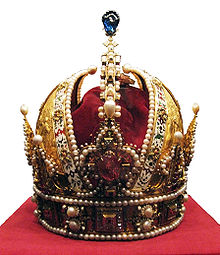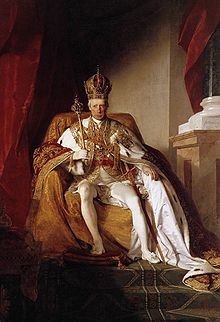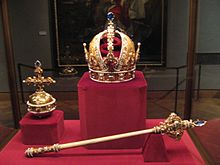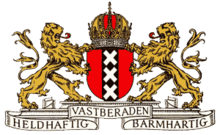- Imperial Crown of Austria
-
The Crown of the Austrian Empire (German: Österreichische Kaiserkrone or Krone des Kaisertums Österreich) was originally the personal crown of emperor Rudolf II. It is therefore also known as the Crown of Rudolf II, or the Crown of the Austrian Empire.
Contents
History
Because the Imperial Regalia of the Holy Roman Empire, especially the Imperial Crown, were all kept in Nuremberg and could only leave the city for the coronation, some rulers had their own personal crowns made. For example, when they attended a session of the Imperial Diet (Reichstag), they attended with their own crowns. The oldest depiction of such a private crown is an etching by the artist Albrecht Dürer of Emperor Maximilian I, where a depiction of a crown is seen that might have influenced the appearance of the crown of Rudolf later.
The Imperial Crown was actually never used for a coronation, since the Empire of Austria, as opposed to the Holy Roman Empire, was a hereditary monarchy under the Habsburg Dynasty, and therefore such an act of legitimization was not seen as necessary. The ceremony was more an act of investiture on the monarch's official ascension to the throne.
The crown of Rudolf II was made in 1602 in Prague by Jan Vermeyen, one of the most outstanding goldsmiths of his time, who was called specially from Antwerp. The crown is made out of three parts: the circlet (Kronreif), the high arch (Kronbügel), and a mitre (Mitra). It therefore follows the model of the mitral crowns, which derive their shape from the cap of bishops.
In the earlier forms of the Western miter the peaks or ‘horns’ were over the ears, rather than over the face and back of the head.File:Mitre evolution.gif The form of miter used in the imperial miter-crown preserved this earlier form. Earlier form of the imperial miter-crown can be seen in the extant portraits of such emperors as Frederick III [1][2] and Maximilian I [3] The bronze effigy of Maximilian I found on his monumental cenotaph in the court church in Innsbruck [4] has a crown with two arches which cross over the top of the miter and the unique form of the imperial crown adopted by Maximilian as Emperor of Mexico File:X-Large Portrait of Maximiliano.jpg[5] appears to have been modeled on this form, but with the half-arches and the eagles on the circlet on the front, back and sides of the imperial crown of Napoleon III.[6] In the later 17th century Baroque form of miter-crown of Leopold I File:Kaiser-Leopold1.jpg[7] the peaks of the miter have been rounded into the hemispherical form Peter the Great would adopt as the Imperial Crown of Russia when he took the title emperor for the Russian sovereign.
Although it is often assumed that the Imperial Crown made for Otto I with its single arch over its inner red cap was the original prototype for the western imperial crown, it is also possible that the Byzantine imperial crown, which in the twelfth century also became closed with two arches, inspired the western emperors to follow their example and also close their crowns with such a pair of arches.
Circlet
The circlet in itself forms a crown — the mitre and the high arch were put in extra, so to speak. It symbolises the royal authority. Out of it rise eight lilies, which were probably inspired by the Bohemian Crown of St. Wenceslas. The lilies are also sometimes associated with the fleurs-de-lis of the Valois. The numeral eight is a theme that was also taken from the Imperial Crown of the Holy Roman Empire, since the circlet is made out of eight plates. In the circlet are precious stones such as spinels, zircons, and pearls. The zircons are cut in such a way that they are flat at the front. The cutting of precious stones was a relatively new technique at the time the crown was made.
Mitre
The mitre symbolises the divine right to rule, and the spiritual position of the emperor: during the coronation, he was also consecrated symbolically as a deacon. It is turned by 90 °, the areas are shown to the side, so that the high arch goes from the front to the back, just as in the Imperial Crown of the Holy Roman Empire. The mitre is made out of gold, with a band of enamel work, which depicts birds and plants. The mitre is divided into four sections, which represent the high honours of Rudolf II. The first part shows him kneeling, while receiving the Imperial Crown of the Holy Roman Empire in Regensburg as Holy Roman Emperor. The second shows him riding onto the coronation hill in Pressburg (Bratislava) during his coronation as King of Hungary. The third shows his coronation procession through Prague as King of Bohemia, and the fourth depicts an allegory of his victory over the invading Turks. The inscription inside the arch reads in Latin: RVDOLPHVS II ROM(ANORVM) IMP(ERATOR) AVGVSTUS HVNG(ARIAE) ET BOH(EMIAE) REX CONSTRVXIT MDCII (Rudolf II, August Emperor of the Romans, King of Hungary and Bohemia, Constructed in 1602).
High Arch
The high arch was obviously inspired by the arch from the Imperial Crown of the Holy Roman Empire. It is studded with eight diamonds, which symbolise Christ. The emperor was regarded as governor on earth in the name of Christ. At the top of the arch is a blue-green emerald, which symbolises heaven. The emerald was not cut, but polished.
Sceptre and Imperial Orb
Also belonging to the crown are a sceptre and the Imperial Orb, which was commissioned in 1612 by Rudolf's brother and successor Matthias. It was created by Andreas Ochsenbruck. The shape takes its inspiration from the crown, especially the enamel-work has been copied in its style. A peculiarity of the sceptre is that it is made partly out of "unicorn horn". The sceptre and the orb were already in use before proclamation of the Empire of Austria, sometimes as the Bohemian royal regalia, sometimes for the hereditary private estates (Erbhuldigung) of the Archduchy of Austria.
Crown, sceptre, and orb are kept today in the Schatzkammer (Vienna), the Imperial Treasury in the Hofburg Palace.
Other uses
- A number of beer companies feature the Imperial Crown on their logo, such as the Royal Brewery of Krušovice (cs: Královský Pivovar Krušovice) in the Czech Republic.
- Some cities have their coat of arms crowned by the Imperial Crown. Amsterdam, was granted its coat of arms to be crowned by emperor Maximilian I in 1489 in recognition of its financial support for one of his wars. The crown can be seen on the spire of Westerkerk and adorning the Blauwbrug.
See also
Literature
- Leithe-Jasper, Manfred. The Kunsthistorisches Museum Vienna: The Imperial And Ecclesiastical Treasury. Scala Publisher. 2005. ISBN 978-3-406-42938-5
External links
 Media related to Imperial Crown of Austria at Wikimedia Commons
Media related to Imperial Crown of Austria at Wikimedia CommonsCrowns English, Scottish, Welsh
and British crowns
(by chronology)Palatine Crown · Crown of Scotland · St Edward's Crown · Crown of Mary of Modena · State Crown of George I · Coronet of Frederick, Prince of Wales · Coronation Crown of George IV · Crown of Queen Adelaide · Imperial State Crown · Small diamond crown of Queen Victoria · Crown of Queen Alexandra · Coronet of George, Prince of Wales · Crown of Queen Mary · Imperial Crown of India · Crown of Queen Elizabeth · Coronet of Charles, Prince of WalesHoly Roman Empire,
German, Austrian,
Bohemian
and Italian crownsIron Crown of Lombardy · Reliquary Crown of Otto II · Crown of Otto III · Reliquary Crown of Empress Cunigunde · Reliquary Crown of Henry II · Imperial Crown of the Holy Roman Empire · Salian Funeral Crowns of Spires · Kamelaukion of Frederick II or Constance of Sicily · Reliquary Crown of Charlemagne (14th century) · Crown of St. Wenceslas (Bohemian lands) · Crown of Blanche of Valois (Bohemian lands) · Electoral Hat of Saxony · Ducal hat of Styria · Archducal hat (Archducal hat of Tyrol · Archducal hat of Joseph II) Crown of the Grand Duchy of Tuscany · Imperial Crown of Austria · Crown of Frederick I (Prussia) · Crown of Charlotte (Prussia) · Imperial Crowns of Charles VII · Napoleonic Crown of Italy · Royal Crown of Bavaria · Royal Crown of Württemberg · Royal Crown of Hanover · Grand Ducal Crown of Baden · Crown of Empress Elizabeth (Austria) Crown of Wilhelm I (Prussia) · German State Crown · Crown of Wilhelm II (Prussia)Polish crowns Crown of Bolesław I the Brave · Swedish Crown · Muscovy Crown · Hungarian Crown · Homagial Crown · Funeral Crown · Queens Crown · Crown of Augustus II · Crown of Augustus III · Crown of Maria Josepha · Płock DiademRussian crowns "Cap of Monomakh" · Crown of Kazan Tzardom · Crown of Tsar Michael Fyodorovich · Cap of Monomakh of the second set · Diamond crown of Tsar Peter I · Diamond crown of Tsar Ivan V · Altabas crown of the third set · Crown of Empress Catherine I · Crown of Empress Anna Ivanovna · Great Imperial Crown · Maltese Crown · Small Imperial CrownFrench crowns Crown of Charlemagne · Sainte Couronne · Crown of Louis XV · Crown of Napoleon I · Crown of Charles X · Crown of Napoleon III · Crown of Empress EugenieOther European crowns Crown of Crown Prince Carl (Norway) · Crown of Christian IV (Denmark) · Crown of Christian V (Denmark) · Crown of Zvonimir (Croatia) · Crown of Eric XIV (Sweden) · Crown of William I (Netherlands) · Crown of William II (Netherlands) · Crown of Norway · Crown of Portugal · Crown of the Queen of Norway · Crown of Elisabeta (Romania) · Crown of Maria (Romania) · Holy Crown of Hungary (Hungary) · Crown of Peter I (Serbia) · Crown of Martin of Aragon · Royal Crown of Spain · Crown of Greece · Papal Tiara · Crown of Rus (Ukraine) · Steel Crown of RomaniaNon-European crowns Crown of Faustin I (Haiti) · Empress Crown (Iran/Persia) · Great Crown of Victory (Siam/Thailand) · Kiani Crown (Iran/Persia) · Imperial Crown of Brazil · Imperial Crown of Mexico · Crown of Sri Vikrama Rajasinha of Sri Lanka · Pahlavi Crown (Iran/Persia) · Crown of Silla (Korea) · Crown of Hawaii · Crown of Tahiti · Crown of Madagascar · Crown of Ranavalona III · Silver crown of Emperor Tewodros (Ethiopia)See also Coronation · Crown Jewels · Heir Apparent · Heir Presumptive · King · Monarchy · Queen · Regalia · Royal FamilyCategories:- Austria-Hungary
- Crowns
- National symbols of Austria-Hungary
- Regalia
- State ritual and ceremonies
- Secular and Ecclesiastical Treasury
Wikimedia Foundation. 2010.








